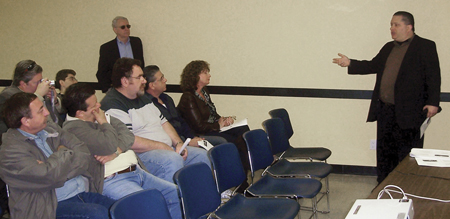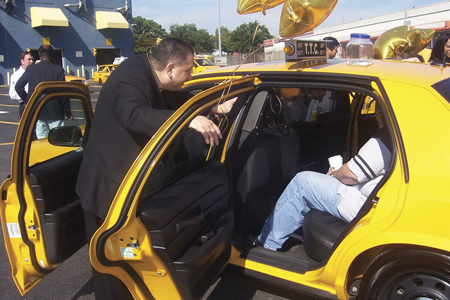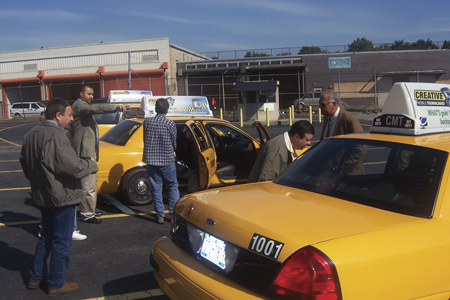 COMMISSIONER’S LETTER COMMISSIONER’S LETTER
As
most of you may have already heard, the TLC is considering a taxicab
rate of fare adjustment. Also, the new taxicab technology customer service
enhancements will soon be in every taxicab.
While
it is important to note that the fare adjustment is still just a proposal
at this point, and not yet a “done deal,” the taxi technology
initiative – which has been in the making for several years and
was promised to passengers some time ago – is very much a “done-deal.”
I would like to spend some time talking about both of these important
issues.
New Taxicab Technology Improvements Coming Soon!
I
am pleased to report that we are nearing the next step in the customer
service technology enhancement project – which includes acceptance
of credit/debit cards, driver text messaging, electronic capture of
trip sheet data and passenger information screens. In brief, we have
completed testing to ensure that the technology works and are now just
weeks away from publicly rolling out as many as 50 cabs equipped by
each of the four technology providers, a 200 cab total.
In
order to help keep everyone up to speed on this project, we have embarked
on an aggressive outreach campaign in a number of ways, most notably,
in an industry demonstration summit held on Saturday, September 30 as
well as the publication of brochures and visits to the airport taxi
holds to explain the new technology to drivers.
These
efforts have two goals:
- to
help the industry understand what is on the way and how it will benefit
them and improve the riding experience all around; and
- to
clear up misconceptions and disinformation that is floating around
out there.
Simply
put, this project is all about helping both customers and drivers by
bringing the taxicab industry into the 21st Century. I should point
out that some of the new technology that I will be describing exists
piecemeal in taxicabs around the world right now at this very moment…it
had just never before been integrated in a single comprehensive package
as we have done here in New York City.

TLC
Chief of Staff Ira Goldstein (standing, right) answers questions at
a
recent industry only Customer Service Technology Enhancement Seminar/Demonstration.
Technology Benefits Drivers
What
are the anticipated benefits for drivers?
•
Bigger tips;
•
No more trip sheets to fill out (that means no more trip sheet summonses!);
•
More business – more passengers to serve with less cruising time.
Credit & Debit Cards
First,
this program will allow every taxicab passenger to pay for their ride
with a credit or debit card, a consumer option that is a proven necessity
for virtually every merchant and service provider here in the U.S. and
around the world. Every indication is that credit and debit card use
will speed transactions to the point where they may even actually be
faster than using cash and will hopefully result in bigger tips and
more trips.

TLC
Chief of Staff Ira Goldstein explaining the new
Customer Service Technology systems to a fleet agent in an equipped
vehicle
at the recent Industry Technology Seminar/Demonstration.
Passenger Information Screens
In
what would be the most visible aspect of them all, the system will also
include a passenger information screen located in the rear compartment
of each taxicab and mounted to the partition. This screen will become
the passenger’s portal for:
•
“silent” safety and public service announcements,
•
an electronic map that allows them to watch their trip through the city,
•
possibly news,
•
sports,
•
weather, and
•
other kinds of entertainment and special content, and
•
will even help them pay their fare at the end of the ride.
Remember,
the screen is a necessary component to processing the credit or debit
card transactions. It will also hold all the information that now exists
only on the delicate paper stickers and maps that exist in taxicabs
today, which had previously been our only means of communicating with
the passenger.
It
is 2006, and we can do better than that! Also, this will not be the
return of the “talking taxi” – as passengers can turn
the devices off, causing them to be silent for most of the ride.
Text Messaging & Location Technology
The
primary type of phone call the TLC receives through 311 is the report
of property lost by passengers in taxicabs which represent over 54%
of the calls received last year. We would like to communicate better
and more effectively with drivers on the streets, to let them know if
passengers recently left valuables behind, about emergencies that may
arise, and to match empty cabs with people who want to fill them.
For
example, two way text messaging and vehicle location technology allows
us to send questions or information to drivers (only while they are
stopped or moving slowly) on a real time basis……such as:
Do you have a laptop in your rear seat? Water main break on Third Avenue.
Queen Mary II docking at Brooklyn Cruise Terminal at 1 p.m...-..useful
information and questions that either need no answer, or can be answered
with a single preprogrammed button.
We
would actually be able to narrow down the number of taxicabs to where
the messages are sent to the immediate vicinity of where cabs are needed.
This is clearly non-intrusive information that benefits both the driver
and the passenger, and cannot be accomplished without location technology
such as Global Positioning Systems (GPS).
The
disinformation I mentioned earlier concerns rumors that the TLC will
use vehicle location technology to “track” drivers by collecting
new kinds of information. The reality, frankly, is much less sensational.
Today,
every driver in the taxi industry has a paper trip sheet and a clipboard
and they are required to scribble down certain details….time,
pick up location, destination, fare, etc. These pieces of paper must
be stored for three years. Now, this very same information – no
more, no less – will be collected electronically and automatically.
No more trip sheets, no more summonses for poorly or incorrectly filled
out trip sheets, but lots of convenience and efficiency.
To
reiterate…..the only information that will be collected through
the GPS vehicle location systems is the same information that is collected
today, except that it is not on paper.
For
example, for statistical purposes only, if we need to know how many
on duty taxicabs are available during rush hour at certain intersections,
we will obtain the number only and will not be interested in whether
your taxicab was one of them. In fact, information gleaned from these
“electronic trip sheets” could prove useful in calculating
future rate of fare adjustments.
The
bottom line, though, is that anyone who tries to convince you that we
will be using this information for anything other than improving efficiency
and customer service is attempting to play on your fears for whatever
political agenda they are promoting.
Who is Going to Pay for These Systems?
One
question that we hear a lot is “who is going to pay for these
systems?” The simple answer is medallion owners, not drivers.
The only cost that drivers will incur is the approximately 3% to 4%
credit/debit card transaction fees which, for a $20 fare would represent
less than $1.

TLC
Chief of Staff Ira Goldstein making a presentation on the new technology
to taxi industry members at a recent industry only demonstration.
How Much Will the Systems Themselves Cost?
There
is no “one cost” that could be quoted for the systems, because
there are four different companies that will be marketing their technology
packages as competitively as possible. But it is safe to say that, depending
on whether the company someone chooses uses advertising to offset costs,
the entire three year cost of ownership could range anywhere from $2,900
to $7,200…complete.
It
could even be said that choosing a company and signing up for a package
is very much like choosing a cell phone account, where the price varies
depending on what services and equipment you choose.
This
is a maximum amount we have set, after aggressive and successful negotiations
to ensure the selection of the very best quality equipment at the most
reasonable price. For medallion owners, less than $1000 per year is
reasonable considering that the taxicab industry has earned at least
$800 million in additional income since the last fare increase in 2004
which was in part made to pay for these systems and that since then,
each owner’s medallion has increased between $158,000 and $245,000
in open market value.
I
should also mention that, for those medallion owners who have existing
contracts with credit card processors and advertising providers, there
is a contractual clause that will allow you to choose any system you
want, with no obligation on your part to go with the company you originally
contracted with for either credit card processing or internal advertising.
If
it is not available already by the time you read this, there will be
a very comprehensive area on the TLC web site (www.nyc.gov/taxi) that
provides additional details about every aspect of the customer service
enhancements. We are justifiably proud of the hard work we have put
into getting to this stage, and while this web site enhancement will
be providing you with essential knowledge, I hope you will forgive us
for using it as a vehicle to show off a little.
Taxicab Rate of Fare Adjustment
On
the fare increase proposal, I had pledged since the last fare increase
in 2004 to periodically revisit the fare structure rather than consider
large adjustments after long periods of time. Just such a review recently
suggested that, while drivers are – on average - compensated at
an appropriate level, the waiting time aspect of the fare formula was
off balance. While both the initial fare and the mileage components
have been “tweaked” over the years, the wait time –
the metered charge for time while the vehicle is either stopped or traveling
slowly – has remained unchanged for a very long time.
One
aspect of the imbalance that I found particularly compelling was that
when comparing the nine major U.S. taxi cities (Miami, Boston, San Francisco,
Boston, Los Angeles, Seattle, Las Vegas, Philadelphia, Chicago and New
York), New York is the lowest among them at $12 per hour in wait time.
The city nearest to us in price came in at $20 per hour – while
Seattle charges $30 per hour.
The
imbalance was clear, and needs to be corrected to ensure that some drivers
earn a “more consistent” wage. Right now, this imbalance
makes it possible for a driver – just due to “the luck of
the draw” – to receive too many “wait time”
fares while other drivers receive more better paying high mileage fares.
At
this point, the TLC is considering an adjustment that would modify the
fare formula from 40 cents per 120 seconds to 40 cents per 60 seconds,
bringing the hourly wait time wage to $24, placing New York City’s
wait time fare squarely in the middle of the comparative road.
Also,
I am recommending that the Commission implement a reverse flat fare
of $45 for trips from anywhere in Manhattan to JFK Airport, which would
complement the highly popular flat fare that has been in place for many
years for trips from JFK to Manhattan. Each of these proposals will
be the subject of a public hearing scheduled for 9:30 a.m. on Wednesday,
October 25 at 40 Rector Street, on the 5th Floor in Manhattan.
Let’s
see what happens! Stay tuned……………
Watch
the TLC web site at www.nyc.gov/taxi for updates,
or to access monthly medallion price charts.
© 2015 TLC Magazine Online, Inc. |